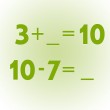Lesson Plans for Elementary School Students
Math Lesson Plan: Finger Counting

Hands are used to get students to identify 5 fingers quickly, or 3 fingers, or 7 fingers. Once students can recognize the number of fingers you are holding up, change it to “what’s missing?”. If I’m showing you 3 fingers, what’s hidden? Three plus ? what ? equals 10? Right, 3 plus 7 (show them hidden fingers) equals 10. This is a quick, easy, fun lesson reinforcing adding to 10.
Objective:
- To learn to add single-digits to equal 10 and learn to subtract from 10, TO MASTERY (if you know 10-7 =3 then 16-7 = 9 is made simpler because you automatically know 7 from 10 is 3 , so 3 plus the 6 from the 16 =9…knowing the facts to 10 then adding the 6….adding is so much easier) . Mastery to 10 makes double-digit subtraction so much easier, so I make sure the grade 2’s also have mastery of this.
Materials:
- math journals, pencils, erasers
- after lesson: ten review questions on the board, either all adding to 10 or 5 adding and 5 subtraction, depending on the level of your class. Pose the questions both horizontally and vertically. (after lesson, have students write in their journals (my classes loved learning the big words))
Adding to Ten
| 3 + __ = 10 | __ + 2 = 10 | |
| 4
+ __ 10 |
__
+ 5 10 |
addend addend sum or total |
Subtracting from Ten
10- 7 = ___ 10-2 = ____
10 10 10 minuend
– 8 –_6 –_5 subtrahend
—- —– ——difference (or answer)
You can check subtraction answers by adding the difference and the subtrahend to get the minuend.
Method:
- Students sit in a learning circle with the teacher.
- Teacher outstretches her fingers and raises them, palm side towards her/himself. How many fingers? 10 Right. (put up 3) How many fingers? 3 Super. (put up 7) How many fingers? 7 Excellent. Try a few more examples so they understand what each number looks like. “That was easy, right? Now we’re going to try something a little harder, but I know you’ll all catch on really quickly. In a few minutes, this will be just as easy.”
- Teacher puts down all fingers, except thumb and two fingers and says, ” 3 plus something = 10. What’s the missing number? 7 Right.” ***touch your 3 fingers together, extend your 7 fingers outwards and flip your hands palms out, showing the 7 fingers stretched out and the three fingers touching fingertips***. ” So, 3 (go back to only 3 fingers extended, rest hidden, palms towards you) plus 7 (***flip hands out to show 7 again) equals 10. That’s a number sentence. It’s a complete thought, just like when we talk and use a sentence, that’s a complete thought. If I just said 3 plus 7, that’s not complete. 3 plus 7 equals 10 tells me a complete number sentence. When I said 3 plus, I want you to make a number sentence for me, adding up to 10. I’d say 3 plus and you would say “3 plus 7 = 10”. Let’s try it. “WHEN YOU ASK THE FIRST NUMBER, YOUR PALMS FACE YOU. WHEN THEY ANSWER THE SECOND NUMBER, GROUP THE FIRST NUMBER FINGERS TOGETHER, FLIP YOUR PALMS OUTWARD SHOWING THE SECOND NUMBER BY EXTENDING THOSE FINGERS. Students can “see” the number sentence….the 3 fingers are held together, touching fingertips, and the other 7 fingers are loose and extended.
- Four plus? (IF THEY SAY six equals ten, tell them what they said wasn’t a complete thought. It was only part of the number sentence. Remind them to say the “four plus” before they finish the number sentence. They need to say the COMPLETE number sentence…..try again…..”Four plus six equals 10″. Great.
- Ask students another one….Five plus? They should say “Five plus five equals ten.”
- One plus?
- Two plus?
- Zero plus?
- Eight plus?
- Six plus?
- Nine plus?
- Seven plus? Seven plus three equals ten. Excellent. Review until they all INSTANTLY recite the correct number sentences. Then begin subtraction. Hold up ten fingers then say, “Ten take away three equals” while you put down three fingers. They should instantly say “seven” because they know 3 plus 7 = 10. Talk about the connection with addition, how you can always check your subtraction work by adding the answer to what you’ve taken away and you will end up with the number you started with. Subtraction in reverse is addition.
- If they have mastered the addition of numbers to 10, then subtraction should be easy for them. If it is not, return to addition to 10 until it is mastered, then return to subtraction again.
- Encourage students to do the number sentence WITH YOU. Show them how to hold down their thumb to show “four” and “nine”. Use a thumb up for “six” or show them how to hold down their first, second and third fingers with their thumb to hold up their pinky finger if they wish, for “six”. Encourage them to look at their fingers when they do it, counting what’s left if they can’t immediate figure out the answer.
- Keep the lesson short and only do it as long as they are involved. Stop lesson if you see any sign of boredom. It can be done many times for very short periods of time. My classes loved doing this finger play adding.
- After lesson, practise answering a few questions from the blackboard, in their math journal (see above example, in materials). Encourage them to use their fingers to “see” the number sentences.
Tags: adding to 10, addition, drills, number sentences, subtracting to 10, subtraction
